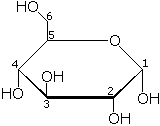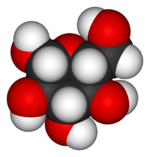Difference between revisions of "Glucose" - New World Encyclopedia
| Line 44: | Line 44: | ||
==The structure of glucose== | ==The structure of glucose== | ||
| − | [[Image:Beta-D-glucose-3D-vdW.png|thumb|left|150px| | + | [[Image:Beta-D-glucose-3D-vdW.png|thumb|left|150px|A space-filling model of glucose]] |
| − | [[Image:D-glucose.svg|frame|right| | + | [[Image:D-glucose.svg|frame|right|The open-chain form of <small>D</small>-glucose]] |
| − | Glucose contains six [[carbon]] [[atom]]s | + | Sugars are classified according to the number of carbon atoms and the type of [[functional group]] (either an aldehyde or ketone group) they contain. Glucose is referred to as an aldo[[hexose]] because it contains six [[carbon]] [[atom]]s (i.e., it is a [[hexose]] sugar) and an [[aldehyde]] group (-CHO). |
| + | |||
| + | The glucose molecule can exist in an open-chain (acyclic) and a ring (cyclic) form. In solution and at neutral pH, the cyclic form is predominant at [[equilibrium]]. When glucose exists in cyclic form, the functional group is not free, making the molecule less reactive. | ||
===Isomers=== | ===Isomers=== | ||
| − | Glucose has 4 optic centers which means that in theory glucose can have (4²-1) = 15 [[Optical isomerism|optical stereoisomers]]. Only 7 of these are found in living organisms, and of these [[galactose]] (Gal) and [[mannose]] (Man) are the most important. These eight isomers (including glucose itself) are all [[diastereoisomer]]s in relation to each other and all belong to the [[Monosaccharide#Isomerism|<small>D</small>-series]]. | + | Glucose has 4 optic centers which means that in theory glucose can have (4²-1) = 15 [[Optical isomerism|optical stereoisomers]]. Only 7 of these are found in living organisms, and of these [[galactose]] (Gal) and [[mannose]] (Man) are the most important. These eight isomers (including glucose itself) are all [[diastereoisomer]]s in relation to each other and all belong to the [[Monosaccharide#Isomerism|<small>D</small>-series]]. |
| − | |||
| − | |||
==Natural sources of glucose== | ==Natural sources of glucose== | ||
Revision as of 21:59, 28 July 2006
| Glucose | |
|---|---|

| |
| Chemical name | 6-(hydroxymethyl)oxane-2,3,4,5-tetrol |
| Synonym for D-glucose | dextrose |
| Varieties of D-glucose | α-D-glucose; β-D-glucose |
| Abbreviations | Glc |
| Chemical formula | C6H12O6 |
| Molecular mass | 180.16 g mol−1 |
| Melting point | α-D-glucose: 146°C β-D-glucose: 150°C |
| Density | 1.54 g cm-3 |
| CAS number | 50-99-7 (D-glucose) |
| CAS number | 921-60-8 (L-glucose) |
| SMILES | C(C1C(C(C(C(O1)O)O)O)O)O |
Glucose (Glc), a monosaccharide (or simple sugar), is one of the most important carbohydrates. The cell uses it as a source of energy and metabolic intermediate. Glucose is one of the main products of photosynthesis and starts cellular respiration. The natural form (D-glucose) is also referred to as dextrose, especially in the food industry. This article deals with the D-form of glucose (The mirror-image of the molecule is called L-glucose. See also Isomers-section below)
The structure of glucose
Sugars are classified according to the number of carbon atoms and the type of functional group (either an aldehyde or ketone group) they contain. Glucose is referred to as an aldohexose because it contains six carbon atoms (i.e., it is a hexose sugar) and an aldehyde group (-CHO).
The glucose molecule can exist in an open-chain (acyclic) and a ring (cyclic) form. In solution and at neutral pH, the cyclic form is predominant at equilibrium. When glucose exists in cyclic form, the functional group is not free, making the molecule less reactive.
Isomers
Glucose has 4 optic centers which means that in theory glucose can have (4²-1) = 15 optical stereoisomers. Only 7 of these are found in living organisms, and of these galactose (Gal) and mannose (Man) are the most important. These eight isomers (including glucose itself) are all diastereoisomers in relation to each other and all belong to the D-series.
Natural sources of glucose
- Glucose is one of the products of photosynthesis in plants and some prokaryotes.
- In animals and fungi, glucose is the result of the breakdown of glycogen, a process known as glycogenolysis. In plants - the breakdown substrate is starch.
- In animals, glucose is synthesized in the liver and kidneys from non-carbohydrate intermediates, such as pyruvate and glycerol, by a process known as gluconeogenesis.
The function of glucose
We can speculate on the reasons why glucose, and not another monosaccharide such as fructose (Fru) , is so widely used in evolution/the ecosystem/metabolism. Glucose can form from formaldehyde under abiotic conditions, so it may well have been available to primitive biochemical systems. Probably more important to advanced life is the low tendency of glucose, by comparison to other hexose sugars, to non-specifically react with the amino groups of proteins. This reaction (glycation) reduces or destroys the function of many enzymes. The low rate of glycation is due to glucose's preference for the less reactive cyclic isomer. Nevertheless, many of the long-term complications of diabetes (e.g., blindness, kidney failure, and peripheral neuropathy) are probably due to the glycation of proteins or lipids. Glycosylation is another important type of reaction undergone by glucose.
As an energy source
Glucose is a ubiquitous fuel in biology. Carbohydrates are the human body's key source of energy, providing 4 kilocalories (17 kilojoules) of food energy per gram. Breakdown of carbohydrates (e.g. starch) yields mono- and disaccharides, most of which is glucose. Through glycolysis and later in the reactions of the Citric acid cycle (TCAC), glucose is oxidized to eventually form CO2 and water, yielding energy, mostly in the form of ATP.
As a precursor to other biological molecules
Glucose is critical in the production of proteins and in lipid metabolism. Also, in plants and most animals, it is a precursor for vitamin C (ascorbic acid) production.
Glucose is used as a precursor for the synthesis of several important substances. Starch, cellulose, and glycogen ("animal starch") are common glucose polymers (polysaccharides). Lactose, the predominant sugar in milk, is a glucose-galactose disaccharide. In sucrose, another important disaccharide, glucose is joined to fructose.
All major dietary carbohydrates contain glucose, either as their only building block, as in starch and glycogen, or together with another monosaccharide, as in sucrose and lactose. In the lumen of the duodenum and small intestine the oligo- and polysaccharides are broken down to monosaccharides by the pancreatic and intestinal glycosidases. Glucose is then transported across the apical membrane of the enterocytes by SLC5A1 and later across their basal membrane by SLC2A2 (ref). Some of glucose goes directly to fuel brain cells and erythrocytes, while the rest makes its way to the liver and muscles, where it is stored as glycogen, and to fat cells, where it is stored as fat. Glycogen is the body's auxiliary energy source, tapped and converted back into glucose when there is need for energy.
The body's regulation of glucose
The insulin reaction, and other mechanisms, regulate the concentration of glucose in the blood. A high fasting blood sugar level is an indication of prediabetic and diabetic conditions.
Commercial production
Glucose is produced commercially via the enzymatic hydrolysis of starch. Many crops can be used as the source of starch. Maize, rice, wheat, potato, cassava, arrowroot, and sago are all used in various parts of the world. In the United States, cornstarch (from maize) is used almost exclusively.
This enzymatic process has two stages. Over the course of 1-2 hours near 100 °C, these enzymes hydrolyze starch into smaller carbohydrates containing on average 5-10 glucose units each. Some variations on this process briefly heat the starch mixture to 130 °C or hotter one or more times. This heat treatment improves the solubility of starch in water, but deactivates the enzyme, and fresh enzyme must be added to the mixture after each heating.
In the second step, known as saccharification, the partially hydrolyzed starch is completely hydrolyzed to glucose using the glucoamylase enzyme from the fungus Aspergillus niger. Typical reaction conditions are pH 4.0–4.5, 60 °C, and a carbohydrate concentration of 30–35% by weight. Under these conditions, starch can be converted to glucose at 96% yield after 1–4 days. Still higher yields can be obtained using more dilute solutions, but this approach requires larger reactors and processing a greater volume of water, and is not generally economical. The resulting glucose solution is then purified by filtration and concentrated in a multiple-effect evaporator. Solid D-glucose is then produced by repeated crystallizations.
See also
- HbA1c
- Glycation
- Glycosylation
- Photosynthesis
External links
- EINECS number 200-075-1 (D-glucose)
- EINECS number 213-068-3 (L-glucose)
- CID 5793 from PubChem (D-glucose)
- CID 206 from PubChem (L-glucose)
- More on the chemistry and function of glucose in biology at EvoWiki
- Computational Chemistry Wiki
Credits
New World Encyclopedia writers and editors rewrote and completed the Wikipedia article in accordance with New World Encyclopedia standards. This article abides by terms of the Creative Commons CC-by-sa 3.0 License (CC-by-sa), which may be used and disseminated with proper attribution. Credit is due under the terms of this license that can reference both the New World Encyclopedia contributors and the selfless volunteer contributors of the Wikimedia Foundation. To cite this article click here for a list of acceptable citing formats.The history of earlier contributions by wikipedians is accessible to researchers here:
The history of this article since it was imported to New World Encyclopedia:
Note: Some restrictions may apply to use of individual images which are separately licensed.

